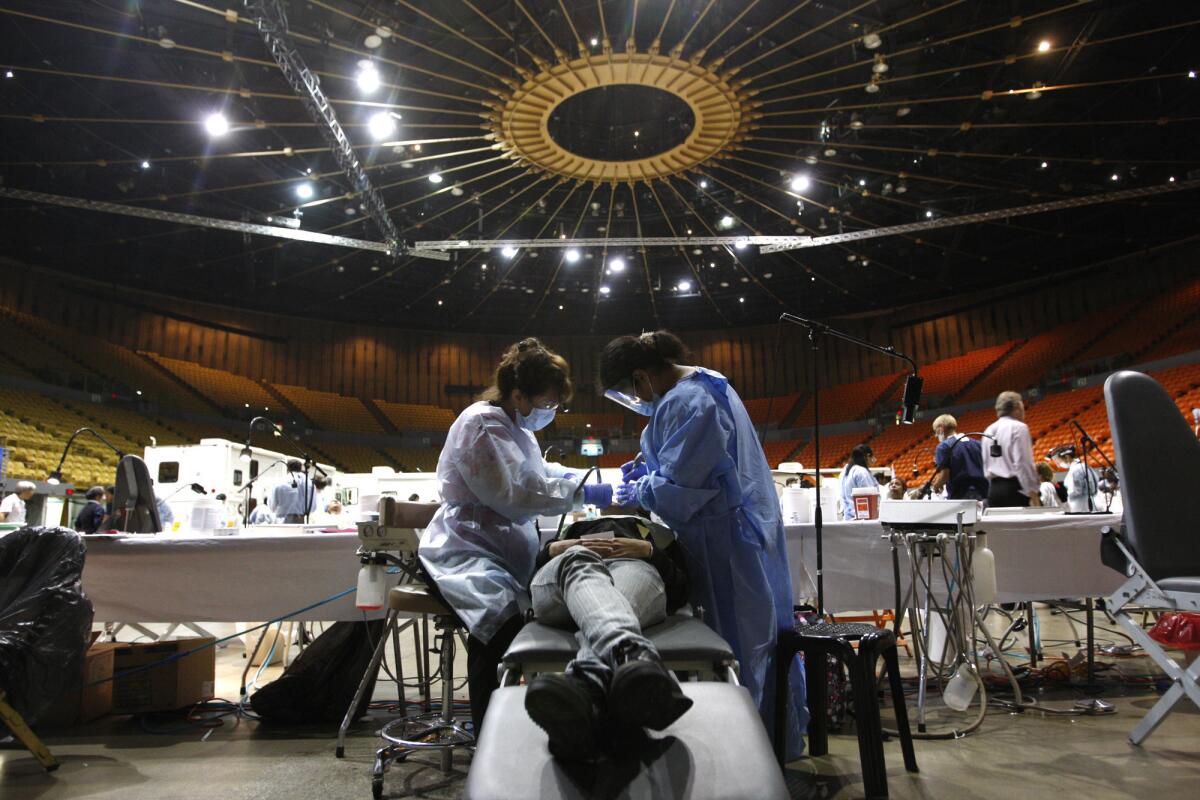The bottom line: It’s time to restore dental care for the poor

SACRAMENTO — State Capitol politicians may have an extra $3.2 billion to play with. Or they may not.
It depends on whose figures you believe: nonpartisan Legislative Analyst Mac Taylor’s or contrarian Gov. Jerry Brown’s.
I tend to have more confidence in Taylor, suspecting that Brown may be lowballing it to be on the safe side so legislators won’t try to overspend and plunge the state back into a deficit hole. That’s noble. But it may not be looking at the world as it really is and making wise use of the revenue that taxpayers are generating.
Taylor last week predicted that the state would take in an extra $4.4 billion through the next fiscal year, compared with the $1.2 billion projected by the governor when he revised his $96.4-billion general fund proposal.
Whoever is right, the politicians should break out the checkbook for at least one new expenditure: restoring adult dental care for poor people. It would be unconscionable not to.
The estimated cost ranges from $75 million to $131 million, depending on how many services are resurrected. That’s relative budget dust.
The background is this: In 2009, when the Capitol was desperately fighting a $42-billion budget deficit, then-Gov. Arnold Schwarzenegger and legislators eliminated adult dental coverage for 3 million Medi-Cal recipients.
“Nobody wants to return to 2009 or 2011 — the $42-billion deficit, or $27 billion when Brown took over—but it’s important to recognize that we made some very harmful cuts for a lot of people in need,” says Senate President Pro Tem Darrell Steinberg (D-Sacramento). “We have an obligation to help restore some of what was lost.”
Restoring dental care shot to the top of Steinberg’s priority list after he visited a Sacramento “dental fair” last fall. Volunteer dentists were caring for poor people.
“I don’t know what I expected, but I certainly didn’t expect what I saw,” the Senate leader recalls. “I thought it was going to be the usual Saturday morning say hello and thank the dentists. But what I saw was appalling. People — mostly working people — waiting hours, not to have their teeth cleaned or a dental checkup, but to deal with abscesses and root canals.
“Dental health is also a key to physical health,” he says. “This is not what California should be about. Now we have a chance to both live within our means and make this right.”
There was another free dental clinic last weekend in San Jose where 2,200 patients were treated. Scores lined up the night before, huddled in blankets.
Dr. Lindsey Robinson, a Grass Valley dentist who is president of the California Dental Assn., was in charge of screening patients. Many brought their children, who had been exempted from the Medi-Cal cuts.
“The children were in good shape,” Robinson says. “They had fillings, crowns, and just needed basic maintenance.
“But when the parents opened their mouths, it was like a bomb had gone off. It was stunning.”
“One father,” Robinson continues, “had had an infected lower molar for six months and been to an emergency room four times. All he could get was pain medication and an antibiotic. We were able to extract the tooth. By the end of the day, the amount of relief expressed in his face was profound.”
The San Jose Mercury News reported one middle-aged woman’s horror story. Unemployed and without dental insurance for several years, most of her teeth had turned black and rotted away. All that remained were three bottom teeth that had bit into and infected her upper gums.
“I’ve been very depressed and hiding out,” the newspaper quoted her as saying. “I haven’t wanted to go to the corner store. I haven’t wanted to talk to people. My kids didn’t want their friends to meet me or go to their schools. A relationship was out of the question.”
At the free clinic, she was fitted with dentures. When she looked in a mirror, she broke down in tears.
Maybe this is bleeding-heart stuff for many conservatives — even Brown, who likes to project a tightwad image and isn’t supporting the move to restore dental care for poor people.
But one Republican, Sen. Bill Emmerson (R-Hemet), a former orthodontist, says he favors “some level” of restoration. He learned of an Alameda County hospital that offers emergency dental care. There, the number of emergency room dental visits doubled to around 4,700 from 2009 to 2011, he says.
“Emergency rooms are overwhelmed as it is,” the senator says. “Dental care can be done more efficiently in Medi-Cal programs.”
There also are other worthwhile priorities for spending any extra money.
Assembly Speaker John A. Pérez (D-Los Angeles) wants to pump $100 million into the starved judicial system and perhaps double that in the succeeding budget. Courthouses have been closed and civil cases long delayed for lack of money.
It’s inexcusable that two branches of government — the executive and legislative — have allowed the third branch upon which democracy depends to deteriorate.
Pérez also would like to sock an extra $200 million into a “rainy day” reserve on top of $1.1 billion proposed by Brown. Another Pérez priority is middle-class college scholarships.
Steinberg also is advocating increased funding for career tech courses and mental healthcare.
One thing you can bank on: There’ll be no tax increase, not even on oil or tobacco. This may disappoint people who make a living fighting taxes — and perhaps even the governor who would enjoy vetoing a tax hike. But legislative leaders won’t allow it. They view it as potential Democratic suicide.
Meanwhile, Brown should spend time with a few of the toothless poor.
More to Read
Start your day right
Sign up for Essential California for news, features and recommendations from the L.A. Times and beyond in your inbox six days a week.
You may occasionally receive promotional content from the Los Angeles Times.







